American Car Spotters Guide - 1965 |
|
|
 |
|
|
|
Acclaimed motoring magazine MOTOR TREND gave the 1965 Car of the Year gong to Pontiac (General Motors) for styling and engineering leadership in the development of personalized passenger cars. It was the third time Pontiac had graced their trophy room with this award. In 1959, when the big, luxury feel was all the rage among car buyers and performance engines were in the process of gaining popularity, Pontiac was successful in improving handling of their vehicles with suspension changes, wider tread, and more positive steering. Their leadership set the pattern for firmer ride, more positive steering, and a styling concept that found immediate acceptance.
The 1961 Tempest, featuring transaxle, curved driveshaft, and independent rear suspension, brought Pontiac another Car of the Year award. Previously there had been a lack of public acceptance of the earlier Tempest concepts, but buyers had a natural tendency to be slow in acknowledging anything too different and in learning to use something in order to extract the most from it. Motor Trend conducted rather extensive tests on the swing-axle Tempest, including a cross-country run over the Continental Divide in heavy winter snow without chains or snow tires as a test of handling and traction. It had noticeable advantages over solid-axle suspensions.
For 1965 Ford called their lineup the "most changed, newest Ford's since 1949" and it was certainly true. The Ford range had been re-engineered from the ground up and was totally restyled. It featured a quiet ride, comfortable interiors, and the new luxurious appointments were marketed heavily. The biggest news was the addition of a totally new series called the Galaxie 500/LTD. A 2-door and 4-door hardtop were offered. Like the Galaxie 500/XL models, the 289 Challenger V-8 and Cruise-O-Matic transmission were standard equipment.
Both the Galaxie 500 and Galaxie 500/LTD 4-door hardtops came with Silent-Flo Ventilation which had been introduced on Thunderbird the year before. There were 2-door and 4-door sedans in both the Custom and Custom 500 series. In addition to the 4-door hardtop the Galaxie 500 offered a convertible, a 2-door hardtop, and a 4-door sedan. The Galaxie 500/XL series included a 2-door hardtop and a convertible.
If you were looking for a station wagon, Ford offered five in 1965: the Ranch Wagon, the Country Sedan, the Country Sedan with Dual Facing Rear Seats, the Country Squire, and the Country Squire with Dual Facing Rear Seats. Squires included Galaxie 500-level trim level, woodgrain paneling, and power tailgate window. The power tailgate window was also standard on the Dual Facing Rear Seat Country Sedan. The 1965 Fords had some of the cleanest, crispest styling ever offered on anything to come out of Dearborn. They had a sparkling, fresh appearance that the public loved and bought in record numbers.
1965 was also another banner sales year for the industry. All major makers were offering more models than ever before. All-new styling changes were certainly more evident among certain lines, standing out as '65 models against competitors' cars with all-new sheet metal but only minor styling changes. In styling, Pontiac shared body shells with other GM cars.
|
 |
 |
 |
American Motors Ambassador |
| |
Also see: AMC Car Reviews | The History of Rambler |
| |
Introduced on 7th October, 1965 as a 1966 model, the Ambassador was available with a 232 CID 155 hp Six or 287 CID 198 hp V8, in sedan, 2 door coupe, convertible and station wagon iterations. |
|
 |
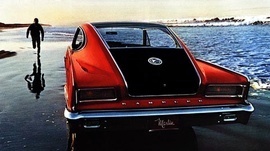 |
 |
American Motors Marlin |
| |
Also see: AMC Car Reviews | The History of Rambler |
| |
The Marlin by Rambler was introduced as the "Newest of the Sensible Spectaculars". It is most easily identified by the unique fastback rear styling, however the front was a little less spectacular. Power disc brakes were standard (tyres were 7.35 or 7.75 x 14), and the Marlin featured reclining seats. The wheelbase was 116 inches, and engines included the 232 CID 155 hp six, 287 CID 198 hp V8, and 327 CID 270 hp V8. Prices started at $3143, and 10,327 were manufactured in 1965. |
|
 |
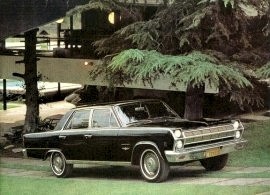 |
 |
AMC Rambler Ambassador 4 Door |
| |
Also see: AMC Car Reviews | The History of Rambler |
| |
For its third generation, the American emerged with what would be its only completely new design. The entire line was treated to neat and trim lines with pleasing simplicity (compared to the more boxy predecessors) with characteristic tunneled headlights with a simple horizontal grille between them. |
|
 |
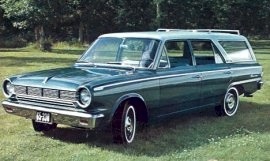 |
 |
AMC Rambler American 330 Wagon |
| |
Also see: AMC Car Reviews | The History of Rambler |
| |
The Rambler American's wheelbase grew by six-inches or 152 mm (to 106 in or 2692 mm). Full coil front springs along with soft rear leaf units, gave the new American an unusually smooth ride, better than many larger domestic cars. The new models also incorporated various parts and components (such as doors) that were interchangeable with AMC's larger cars.
|
|
 |
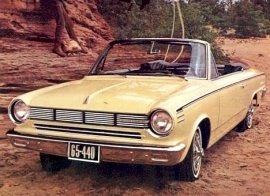 |
 |
AMC Rambler American 440 Convertible |
| |
Also see: AMC Car Reviews | The History of Rambler |
| |
The new styling was the work of famous designer Richard A. Teague, who would go on to design the 1968 Javelin and AMX. Many viewed the newly designed station wagon as the best-looking of any American wagon, with its new, trim lines and ample passenger and cargo room. Led by the top-line 440-series convertible, they were arguably the 1965's most attractive Detroit compacts. |
|
 |
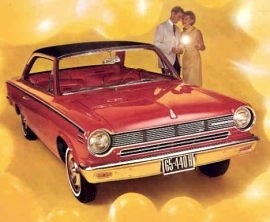 |
 |
AMC Rambler American Hardtop |
| |
Also see: AMC Car Reviews | The History of Rambler |
| |
Advertised as "The Sensible Spectaculars" as part of Roy Abernethy's strategy for AMC to shed its "economy car" reputation and take on the domestic Big Three automakers in new market segments. The year also saw the introduction of a entirely new 232 cu in 3.8 liter overhead valve straight-6 engine that AMC would use through 1979, with a smaller 199 cu in 3.3 liter version being used only during 1966-1970. The same engine was later available in a larger 258 cu in 4.2 liter version (used from 1971-1989) and a 242 cu in 4 liter version that debuted in 1987, known as the Jeep 4.0, which Chrysler would continue through 2006 after its purchase of AMC in 1987. |
|
 |
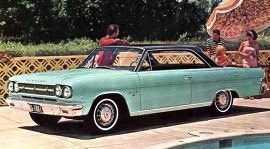 |
|
 |
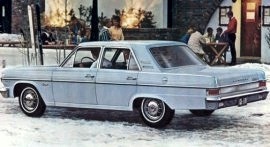 |
|
 |
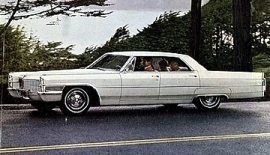 |
|
 |
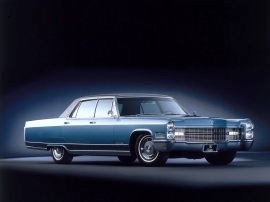 |
|
 |
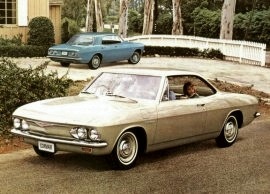 |
|
 |
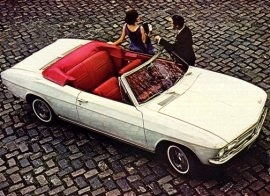 |
|
 |
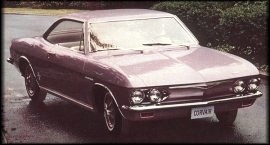 |
|
 |
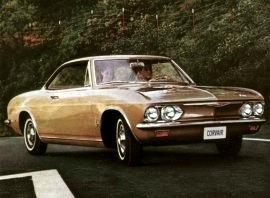 |
|
 |
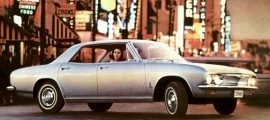 |
|
 |
 |
 |
Chevrolet Stingray Convertible |
| |
Also see: Chevrolet Car Reviews | The History of Chevrolet |
| |
Four-wheel disc brakes were introduced in 1965, as was a "big block" engine option, the 396 cu in (6.49 L) V8. Side exhaust pipes were also optional in 1965 and continued through 1967. The introduction of the 425 bhp (317 kW) 396 cu in (6.49 L) big block in 1965 spelled the beginning of the end for the Rochester fuel injection system. The 396 cu in (6.49 L) option cost US$292.70 while the fuel injected 327 cu in (5.36 L) engine cost US$538.00. Few people could justify spending US$245.00 more for 50 bhp (37 kW) less, even if the FI cars offered optional bigger brakes not available on carbureted models. With only 771 fuel-injected cars built in 1965, Chevrolet discontinued the option the following year. Chevrolet would up the ante in 1966 with the introduction of an even larger 427 cu in (7.00 L) Big Block version, creating what would be one of the most collectible Corvettes ever. |
|
 |
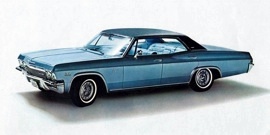 |
 |
Chevrolet Impala Caprice |
| |
Also see: Chevrolet Car Reviews | The History of Chevrolet |
| |
Redesigned again in 1965, the Impala set an all-time industry annual sales record of more than 1 million units in the U.S., which has never been bettered. All new full-size Chevys eschewed the "X" frame for a full-width perimeter frame, a totally new body which featured curved, frameless side glass (for pillarless models), sharper angled windshield with newly-reshaped vent windows, and redesigned full-coil suspension. In 1965, Chevrolet introduced the Impala Caprice. Beginning with the four-door hardtop sedan body, Impala Caprices received unique upholstery, wood grained accents on the dashboard and specialty pulls on the insides of the doors. The old 409-cubic-inch (6.7 liter) "W" engine was discontinued early in the 1965 model year, so early-production '65s got the 409, where later-built cars had the 396-cubic-inch (6.5 L) as the big-block option. Two-range Powerglide, as well as Synchro-Mesh 3 and 4-speed manual transmissions were available. As with previous years, Impalas featured more chrome trim inside and out, with pleated tufted upholstery and door panels. |
|
 |
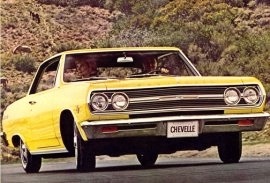 |
|
 |
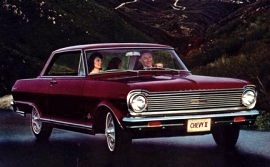 |
|
 |
 |
 |
Chrysler 300 |
| |
Also see: Chrysler Car Reviews | The History of Chrysler |
| |
Chrysler Corporation spent 300 million dollars tooling up for the 1965 model year. The Chrysler received an all new body and longer wheelbase of 124.0 inches. Galvanized sills and full front wheelhouses gave important corrosion protection, and the luxury ride of the New Yorker was enhanced by a constant-velocity joint added to the drive line. |
|
 |
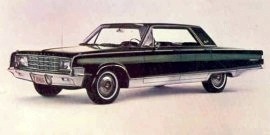 |
|
 |
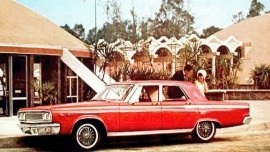 |
|
 |
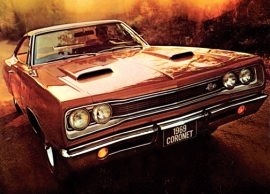 |
|
 |
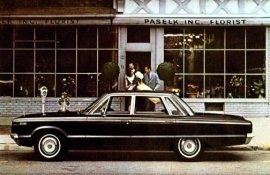 |
|
 |
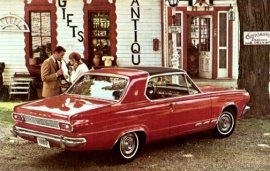 |
|
 |
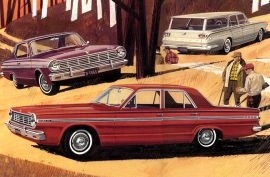 |
|
 |
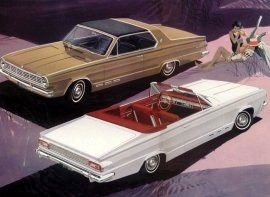 |
|
 |
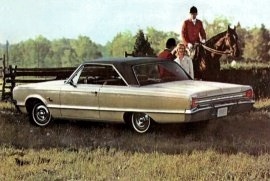 |
|
 |
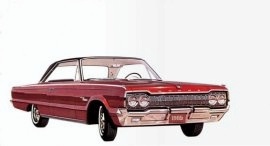 |
|
 |
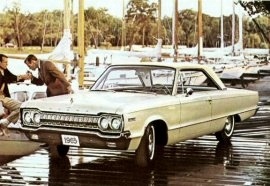 |
|
 |
 |
 |
Ford Custom 2 Door |
| |
Also see: Ford Car Reviews | The History of Ford |
| |
Pictured left is a Ford Custom 2-door Sedan, which had all the big-Ford comforts and features (and many of their extra values) and was one of America's lowest-priced full-size cars. A Ford Custom 4-door Sedan was also available. |
|
 |
 |
|
 |
 |
 |
Ford Custom Special 4 Door |
| |
Also see: Ford Car Reviews | The History of Ford |
| |
The Ford Custom Special was a specially-equipped model - a Custom 4-door Sedan with Galaxie 500 level trim and the other items shown on the advertisement shown left. It was sometimes referred to as the "January White Sale" Ford. |
|
 |
 |
 |
Ford Galaxie 500 4 Door Sedan |
| |
Also see: Ford Car Reviews | The History of Ford |
| |
The Ford Custom, Custom 500, and Galaxie 500 4-door Sedans offered the convenience of an optional folding rear seat. It nearly doubled the luggage capacity, providing a 3 by 5- foot flat, level space conveniently behind the front seat. |
|
 |
 |
|
 |
 |
|
 |
 |
|
 |
 |
 |
Ford Galaxie 500 Convertible Interior |
| |
Also see: Ford Car Reviews | The History of Ford |
| |
The Galaxy 500 featured easy-to-clean vinyl in a choice of six colors. Carpeting, curved side glass, bright-metal trim, and stretch top boot were all standard. The convertible also featured a scratch-resistant clear glass rear window, a Ford convertible "first". |
|
 |
 |
 |
Ford Galaxie 500 Convertible Rear Deck |
| |
Also see: Ford Car Reviews | The History of Ford |
| |
The Ford Galaxie 500 Convertible featued a push-button power top that stacked low and flat under a padded, taut, color-keyed boot. |
|
 |
 |
 |
Ford Galaxie 500 LTD 2 Door Hardtop |
| |
Also see: Ford Car Reviews | The History of Ford |
| |
The LTD offered five colors of vinyl roof (Ivy Gold shown), but it was inside that made all the difference. Ford used sofa grade upholstery for the seats, woodlike paneling, pull-down rear arm rest, cut-pile carpeting, and tasteful use of chrome borders and trim. The textured vinyl roofs were color-keyed to blend with the upholstery patterns. Other inclusions were courtesy lights overhead, under the instrument panel, and on the door sides, which came on automatically whenever a front (or rear) door was opened. |
|
 |
 |
|
 |
 |
 |
Ford Galaxie 500 LTD 4 Door Hardtop Interior |
| |
Also see: Ford Car Reviews | The History of Ford |
| |
The Scotchguard-protected LTD nylon fabric interiors were available in a choice of black, burgundy, ivy gold, blue, Palomino, or turquoise. The LTD versions featured extra foam cushioning over the lesser Galaxies. |
|
 |
 |
 |
Ford Galaxie 500 LTD 4 Door Dash |
| |
Also see: Ford Car Reviews | The History of Ford |
| |
For the 1965 models Ford moved the instrument panel a full five inches forward to allow for more knee and leg room. The Fresh air vent control knob was re-located to the lower center of panel. LTDs featured arm rests with integral lift-tab door handles. |
|
 |
 |
 |
Ford Galaxie 500 XL |
| |
Also see: Ford Car Reviews | The History of Ford |
| |
The Galaxie 500 XL was a little more sporting in character than the LTD. While the image at left shows a vinyl roof, on the XL this was actually a $75.30 option. |
|
 |
 |
 |
Ford Galaxie 500 XL |
| |
Also see: Ford Car Reviews | The History of Ford |
| |
The XL Convertible came standard with the 200-horsepower Challenger V-8, although you could choose optional engines up to 425-horsepower. Another XL touch was the special red and white courtesy lights located on the inside of the doors. |
|
 |
 |
 |
Ford Galaxie 500 XL |
| |
Also see: Ford Car Reviews | The History of Ford |
| |
The Ford Galaxie 500/XL Convertible came standard with bucket seats, V-8 engine, and Cruise-O-Matic transmission. |
|
 |
 |
 |
Ford Galaxie 500 XL Interior |
| |
Also see: Ford Car Reviews | The History of Ford |
| |
The image shown left give a good comparison over the Galaxie LTD interior above. Note the slim, classic bucket seats with pleated vinyl trim. There were in fact eight upholstery choices. The XL's interior used tasteful, bright-metal trim and had color-keyed nylon-rayon carpeting. You could option a reclining passenger seat and head rests. |
|
 |
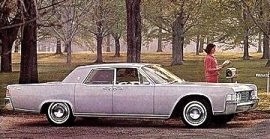 |
|
 |
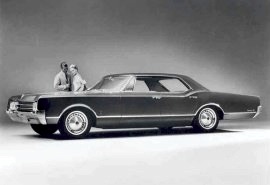 |
|
 |
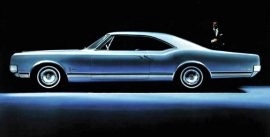 |
|
 |
 |
|
 |
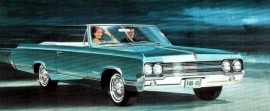 |
|
 |
 |
|
 |
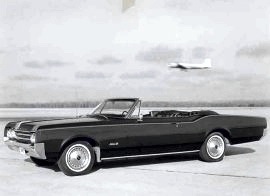 |
|
 |
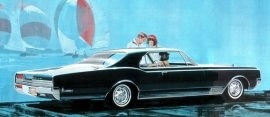 |
|
 |
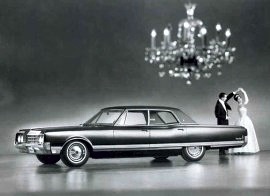 |
|
 |
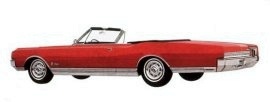 |
|
 |
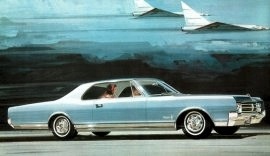 |
|
 |
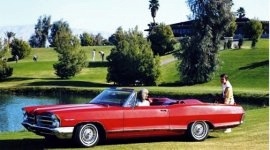 |
|
 |
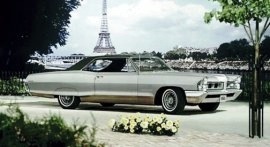 |
|
 |
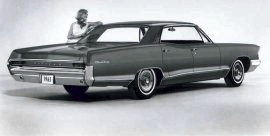 |
|
|
